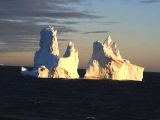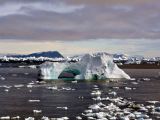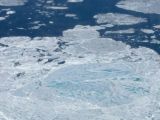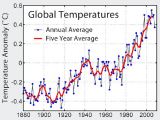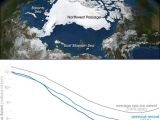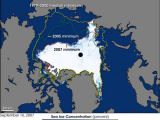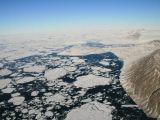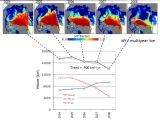I've been trying to find an appropriate title for this article for quite some time now, but I couldn't come up with one that would draw as many readers to it as possible. This piece is about the challenges that are brought forth by global warming, the people fighting to sooth or exacerbate them, the animals that will die if we don't act, the ice that will melt if we do nothing, as well as many other things. I will also discuss some of the agendas behind people and groups who oppose the idea of global warming, as I've grown tired of having witless comments posted on the site, saying that climate change does not exist.
I've always found it amazing how people who are so indoctrinated with a certain belief system can go past all the concrete evidence they are shown, and still believe in their own, completely-off idea. A basic representation is your average global warming critic. And I'm not talking here about the scientists whose researches give results differing from the accepted view, but about the average people who think that they know the way climate change science is done.
Now, this individual will post a comment to an article and say something along the lines of “all the information in here is biased, and the studies are bogus,” with fewer or more words. The problem is that these so-called self-taught “scientists” gracefully fail to consider the fact that the one study their objections are based on was conducted by some obscure research institute or foundation, most likely sponsored by industry lobbyists. And, of course, I'm talking about the fossil fuel industry, including companies related to exploiting oil, natural gas and coal for profits.
The Poles
This type of exploitation brings us, by some twisted turn of events, to the Arctic. “How is it that they're talking about drilling in the Arctic? Wasn't there supposed to be thick ice there?” you may be asking yourselves now. Well, this is the catch – the levels of ice at the North Pole have decreased so significantly that researchers are now talking about having the entire cap disappear during the summer within a few decades. This means that the Arctic will be replaced by a pond of sorts, or another sea. The implications, if something like this were to happen, are unthinkable.
Among the largest threats to the ice sheets are, you've guessed it, greenhouse gases, which have been linked to this effect by a long series of long-term studies that, unlike others, actually relay on science. Just recently, in a NASA paper, the American space agency revealed that “The near-zero replenishment of the multi-year ice cover, combined with unusual exports of ice out of the Arctic after the summers of 2005 and 2007, have both played significant roles in the loss of Arctic sea ice volume over the [satellite] record.” (Ron Kwok, ICESat team member, JPL, NASA).
This research, conducted over four years, revealed a worrying trend in only a short period of time, confirming other studies arguing that the ice would begin melting faster and faster as the years went by. It's important at this point to note that there are two types of ice in the Arctic, the thinner, seasonal one, generated during the winter and melted in the summer, and the multi-annual, thicker variety, which is able to endure for many years.
Using measurements from its Ice, Cloud and land Elevation Satellite (ICESat), the American space agency has proven that the most dramatic changes occurred between 2004 and 2008, when the balance between the two types of ices drastically shifted. These results essentially imply that the ice meltdown that happens each summer takes up more of the ice sheets than freezing adds during the winter season. As a result, the ice caps are constantly shrinking, and will continue to do so, as long as global warming exists.
The Critics
While people with common sense have realized that the ice at the poles is melting for a very long time, others have tried to downplay the importance that human-made activities have on this entire process. Companies in the fossil fuel industry have spent millions of dollars on lobbyists in Congress and at the White House, as well as on so-called research institutes, which came up with all sorts of explanations for why global warming is happening.
Many critics simply say that studies show a cooling trend in the Antarctic, and that the Arctic is only experiencing a temporary warming. But the studies they based their claims on only span a few years, and are not decade-long investigations, such as those ran by NASA from the agency's satellites. It's simply not possible to base your entire arguments on two or three years of observations. The Arctic can indeed accumulate more ice over three years, but if it loses ice over ten years, then the trend is for melting, not cooling.
The current line of thinking among global warming critics goes something like this,
“Global warming and climate change do not exist, but, if they do, They are a natural trend, and are therefore not caused by man, but, if they are, The problem is not as big as scientists would have you believe.”
It's easy to see in this line of reasoning that the big companies are following a strategy that would reduce their losses to the greatest extent. For some, that is completely unnecessary, considering the fact that consensus already exists among the academic community as to the existence of global warming and climate change. Additionally, literally hundreds of studies have up to this point linked methane and carbon dioxide to these phenomena, and have proven that they have a direct adverse effect on both the atmosphere and the oceans.
What I find to be deeply concerning is the fact that the warming in the Arctic is accelerating a vicious circle, that will see even more warming and melting. Under the frozen soils of the tundra (permafrost), around the Arctic Circle and further north, researchers say, lie vast amounts of trapped carbon dioxide and methane, both dangerous gases for the atmosphere. In a recent study, conducted by researchers in Canada, the United States and Australia, scientists Dr. Pep Canadell, Ted Schuur and Dr. Charles Tarnoca have uncovered the fact that the Arctic permafrost actually holds some 1.5 trillion tons of frozen carbon, about twice as much carbon as contained in the atmosphere.
This is dangerous because global warming has the most devastating effects in the polar regions, where temperature rises are most significant. When this happens over the areas covered with permafrost, it melts the frozen ground, and releases the dangerous gases into the atmosphere. If only one tenth of the greenhouse gases stored under the permafrost are released into the atmosphere, then the levels of carbon dioxide in the air will be brought up to a level never before encountered. Countless animal species, plants and ice sheet are endangered by only a 2-degree Celsius rise in global temperatures, but a vast amount of hydrogen could bring about the forecast Arctic and Antarctic meltdown a lot sooner than anticipated.
“Permafrost carbon is a bit of a wildcard in the efforts to predict future climate change. All evidence to date shows that carbon in permafrost is likely to play a significant role in the 21st century climate given the large carbon deposits, the readiness of its organic matter to release greenhouse gases when thawed, and the fact that high latitudes will experience the largest increase in air temperature of all regions,” explains Candell, the Executive Director of the Global Carbon Project at CSIRO, in Australia.
The Politics and Industry
Canada, Greenland, Kazakhstan, Mongolia, the Russian Federation, the Scandinavian countries and the United States at this point hold the largest permafrost surfaces, and all of them are threatened by increased temperatures. The more greenhouse gases are emitted from these soils, the more warm it gets, and the faster other amounts of methane and CO2 are emitted. This is one of the main reasons why experts keep telling us to act now. If this vicious circle starts going too fast, there will be nothing more for us to do, except take on the full effects of climate change.
It seems amazing to me that some people are so blind by what others tell them that they simply move past such thorough investigations, and believe that they are all part of some conspiracy. Additionally, in some of the comments I've read on the site, I noticed that a lot of GW critics tend to associate the course that the United States are in now, of spearheading the global efforts towards reducing emissions and pollution, with a socialist doctrine promoted by president Barack Obama. How their minds connect these two dots remains a mystery to this day.
Indeed, at first glance, it may seem like a social measure, but that's only because former president George W. Bush was so conservative, and always tried to please his friends in the fossil fuel industry. This is proven by the legislation he passed or attempted to have approved before leaving. The decisions include, among others:
1. Ancient pine woods to be transformed in Pine Woods, a new suburb, following a back-door deal the Bush Administration made with the nation's largest private land owner, Plum Creek Timber; 2. An Environmental Protection Agency (EPA) ruling saying that farmers no longer need to report the amounts of pollutants they put in the ground and in the atmosphere; 3. The removal of a ban that the mining industry was subjected to, which prevented it from dumping wastes from surface coal exploitations within 100 feet (33 meters) of creeks or streams; 4. The opening of lands near national parks for oil and natural gas exploitations, with no consideration for the environment and the decision's impact on local ecosystems.
Finally, in one of the most criticized decisions ever, the president heavily modified (read crippled) the Endangered Species Act (ESA) to the point where potentially harmful development projects, such as opening various plants and factories, no longer need to have the approval of wildlife experts, as they did for decades. This means that, if some entrepreneur wanted to open a coal power plant in a beaver reservation, wildlife management and protection agencies could have done nothing to stop them.
Back to the issue at hand, the fact that Obama is taking on an active role in G8 and at UN meetings, and is trying to get the US to pollute less should be praised, if anything. Conservatives and Republicans are at this point playing the national security card, saying that America needs to be safe, and have sufficient (fossil fuel) resources to withstand any development on the international oil market. And their strong point is that renewable energy (solar plants, wind farms, etc.) are not able to provide the sufficient amounts of energy required.
First, that is bogus. Sufficient advancements have been made to allow for at least 20 to 30 percent of the country's grid to be fueled by renewable energy. Second, it was precisely the government that refused to fund research into better solar cells, more efficient turbines, and in biofuels. With a little bit of effort, the country could have become a leader in alternative energy. Fortunately, states such as California and the United Kingdom have taken it upon themselves to conduct the advance in this matter, imposing regulations that are legally-binding, to reduce pollution by 2020 and 2050.
In their efforts to prevent this, representatives of the fossil fuel industry are playing the economic card, and are suing California, for denying access on its internal market for Canadian oil, for example, which is obtained from highly-polluting sources, such as tar sands. The Western US state is threatened to be brought in front of the World Trade Organization, which recently seems to have collected quite a number of new functions and powers. In a recent TV show, Chevron CEO David O'Reilly said that US 2050 emission goals were “too ambitious,” which translates into “bad for our business.”
The Animals
When all is said and done, scientists argue that the temperature increase on the planet must not exceed 2 degrees Celsius. If this happens, then the floods, droughts and changed weather patterns will bring forth atmospheric manifestations the likes of which we've never seen before. The seasonal phenomena that we've grown accustomed to, such as monsoons and cyclones, will experience a change in patterns, affecting the millions of people they usually help feed. The situation is especially concerning in Asia, where the monsoons are responsible for feeding about half of the planet's population.
Even politicians, despite their “innate” reluctance to accepting global warming, at the last G8 summit, decided to curve greenhouse gas emissions, so as to avoid this temperature increase. Undoubtedly, the most affected ecosystem, if this happens, will be that of the Arctic. Penguins, walruses, polar bears and foxes will all have their natural habitat destroyed. These animals relay heavily on the ice for survival, and changes in the amounts of ice at the Arctic have already negatively affected the polar bear populations. The ice is so thin that it can no longer support their weight, and the bears sometimes swim for tens of miles before finding a patch of ice they can climb to.
Conservation programs are especially difficult to set up under these circumstances, mostly because you cannot hope to save some animals in a specific area if the area itself is no longer there. Setting up polar bear reservations can only be done at the North Pole, but, if the entire cap melts during the summer, than there will be no ice remaining for this population. This is a danger highlighted by environmental groups WWF and Greenpeace, which regularly organize expeditions to the region. The reason why the Arctic is different from the Antarctic is that the former has an ice cap floating on water, while the latter has ices over a continent.
This March, representatives from Russia, the United States, Denmark, Canada and Norway met to discuss the ecosystems of the Arctic. They concluded in a statement that “Climate change has a negative impact on polar bears and their habitat and is the most important long-term threat facing polar bears. The parties agreed that long term conservation of polar bears depends upon successful mitigation of climate change.”
Seal populations in the Arctic were in a recent Durham University study shown to be extremely adaptive to their environment, in that they can migrate to another location when their climate changes. Still, they are accustomed to living in freezing conditions, and if the polar cap melts, then they would have nowhere else to go, considering that Northern Canada and Russia will also be ice-free.
“In general, this approach of looking to the past to understand what might happen in the future has good potential for predicting the impact of environmental change in both marine and terrestrial systems. We’ve shown how a highly mobile marine species responded to the gain and loss of new breeding habitat. The new habitat was quickly adopted, probably because seals migrate annually into Antarctic waters to feed. However, when the ice returned and the habitat was lost, only a small proportion returned to the original source population. The Antarctic population crashed and much diversity was lost,” says professor Rus Hoelzel, from the DU School of Biological and Biomedical Sciences.
In the End
Nobody expects that mitigating the effects of global warming will be easy. Unfortunately for us, it's not just the effort of changing infrastructures that prevents us from taking firm steps towards reducing our carbon footprint, but also the opposition from corporation and businessmen who have an interest in maintaining the status-quo, for their own profits. In its report “Smoke, Mirrors & Hot Air,” the Union of Concerned Scientists slammed ExxonMobil for “underwriting the most sophisticated and most successful disinformation campaign since the tobacco industry,” as well as for “funneling about $16 million between 1998 and 2005 to a network of ideological and advocacy organizations that manufacture uncertainty on the issue.”
Additionally, more and more critics fail to comprehend the fact that it's our planet and, ultimately, our lives on the line, and continue to play the costs card, saying that changing our ways is too large of an investment, and that there is insufficient evidence to prove that global warming is man-made. These are the same people who advocate national and energy security, and are also responsible for bringing countries such as the United States to a point where they emit the largest amounts of pollution in the world. Fortunately, it may be that new leaders will break this cycle, despite opposition.
One thing you, the readers, need to understand, is that companies and those with an interest in maintaining the status-quo, will go at any lengths to cast doubts and confusion over reliable scientific data. They will manufacture evidence, which they will then relate to existing studies, and turn them on their heads. These points of view will appear in networks such as Fox in the US, and so-called experts will be brought in.
People such as NASA's Roy Spencer are the prime target for these individuals, precisely because the American space agency offered the most conclusive evidence that global warming and climate change exist. By interviewing him, those who will have you believe that global warming is a myth will try to make you think that disagreement exists even within the agencies and research institutes supporting global warming, which is not true. Everyone is entitled to their own opinion, but hanging on to it in front of overwhelming evidence is not good science, but cheap propaganda.
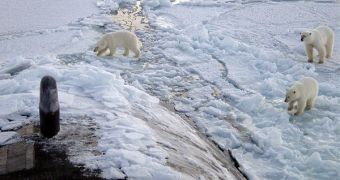
 14 DAY TRIAL //
14 DAY TRIAL // 
